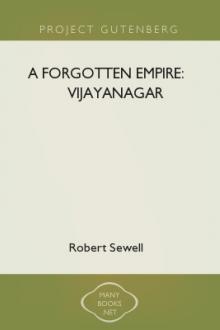A Forgotten Empire: Vijayanagar by Robert Sewell (short story to read TXT) 📕

- Author: Robert Sewell
- Performer: -
Book online «A Forgotten Empire: Vijayanagar by Robert Sewell (short story to read TXT) 📕». Author Robert Sewell
Four others are mentioned before we come to the great Visvanatha Nayakka, who founded an hereditary dynasty, though himself only a deputy of the crown. He ruled Madura from 1559 to 1563. Muttu Krishnappa (1602 — 1609) seems to have been the first to assume royal titles at Madura. His son, Muttu Virappa (1609 — 1623), is stated, in the narrative of the Portuguese writer Barradas (above, p. 230), to have paid a tribute in A.D. 1616 to the Vijayanagar king at Chandragiri of 600,000 pagodas; he had several vassal kings under him, and must have already obtained great power. It is possible that, in the time of Nuniz, Madura was not one of the greater provinces, but that it became so later.
The names Choromandel, Negapatam, and Tanjore are easy to distinguish in this list. “Bomgarin” I cannot identify, though the termination, GARIM, may represent GIRI, “mountain.” “Dapatao” may be Devipatnam. “Truguel” seems to have some affinity with Tirukovil. It cannot be the “Truguel” mentioned by Barros and others as one of the fortresses given to Asada Khan by the king of Vijayanagar (above, p. 175), because those were close to Belgaum, while this “Truguel” was in the extreme south “Caullim” may be Kayal.
[622] — Above, p. 300, note 1.
[623] — Udayagiri.
[624] — Kondavid.
[625] — Pennakonda.
[626] — (?) Kanigiri, Nellore district. Codegaral MAY represent Gandikota, the termination GIRI, “hill,” being substituted for KOTA, “fort,” E.G. GANDIGIRI.
[627] — Siddhout or Siddhavattam, Cuddapah district.
[628] — The passage is incomplete, and I have rendered it as seems reasonable. It runs, “VINTE E CIMCO MILL E QUINHENTOS DE CAVALLO E,” &c. Looking at the other lists of troops, it cannot be supposed that this chief had to provide 25,000 horse. It seems more probable that such a word as PIAES was accidentally omitted after MILL, and that MILL should have been repeated before QUINHENTOS.
[629] — Perhaps Rachol, near Goa.
[630] — Bicholim (?).
[631] — “Bengapor” as elsewhere spelt, I.E. Bankapur, south of Dharwar.
[632] — See the last sentence of the chronicle of Paes (above, p. 290), where a town “on the east” is called the new city which Krishna Deva built in honour of his favourite wife. The writer has evidently been confused in that statement, for it seems clear that the town so founded was Nagalapur, the old name for Hospett, with which it is distinctly identified in other places. This town “on the east” is said, in the sentence referred to, to bear the name “Ardegema,” and the locality is hard to determine. “East” of what? If east of Nagalapur be meant, then Ardegema or Ondegema (GEMA probably represents GRAMA, “village”) might have been a suburb of that town. If east of the capital be intended, I cannot identify the place. But these places evidently were close to the capital, bordering on the crown lands. This, I take it, is the meaning of “bordering on the lands (TERRA) of Bisnaga.”
[633] — These three places I cannot identify. “Diguoty” may perhaps be Duggavatti, in the Harpanhalli division of the Bellary district. “Darguem” suggests “Droog” or “Durgam.” The word is applied to a hill-fort, of which there are many in the neighbourhood. One of the most important was Rayadrug, south of Bellary. One of the ghat roads leading eastwards from Goa is called the “gate de Digui” in old maps.
[634] — Possibly Kalale in Mysore, a place fifteen miles south of that capital. It is said to have been founded in 1504 by a noble who was connected with the Vijayanagar royal family (Rice’s gazetteer, ii. 255).
[635] — Unidentified.
[636] — Perhaps Budehal in Mysore, which like Kalale was founded by a Vijayanagar officer, and contains several sixteenth-century inscriptions. It is in the Chittaldrug division, forty miles south of that place.
[637] — Mangalore.
[638] — Unidentified.
[639] — ROUPA. Linen cloth. The word is not used of cotton, and the next sentence shows that cotton did not grow in that tract.
[640] — I hazard the suggestion that this may be a mistake of the copyist for “Avati.” This place, now a village in the Kolar district of Mysore, was in the fifteenth century an important place, a ruling family having been founded here by the “Morasu Wokkalu” or “Seven Farmers” (Rice, “Mysore and Coorg,” ii. 20). The description applies to it fairly well.
[641] — Calicut.
[642] — Either “the ghats,” or perhaps Gutti (Goofy). The rich Vajra Karur diamond mines are about twenty miles south-west of Gooty, where are the remains of a very fine hill-fortress.
[643] — See note above, p. 368.
[644] — Mudkal.
[645] — Raichur.
[646] — I.E. of the Hindu religion, not Muhammadans.
[647] — NOVEIS in the original, probably for NOTAVEIS.
[648] — Telugus.
[649] — This was certainly not the case.
[650] — The Ganges.
[651] — Its history is known from A.D. 1304, when it was acquired by Ala-ud-Din Khilji from the Rajah of Malwa.
[652] — De Montfart’s “Survey of all the East Indies.” Translation, edition of 1615, p. 34.
[653] — Purchas, i. 218.
[654] — See Yule and Burnell’s Dictionary, S.V. “Maund.”
End of The Project Gutenberg Etext of A Forgotten Empire: Vijayanagar; A Contribution to the History of India





Comments (0)